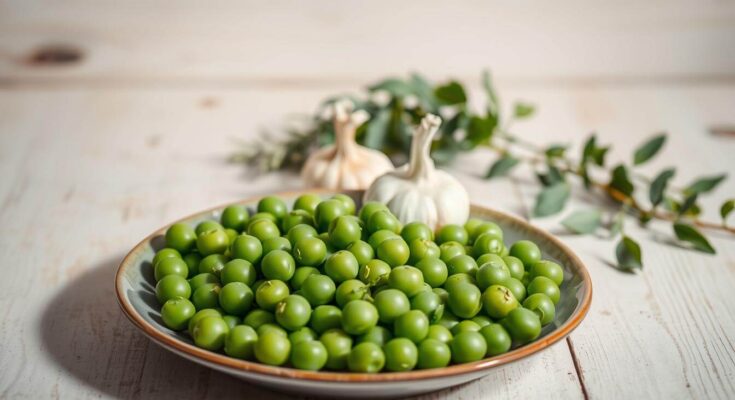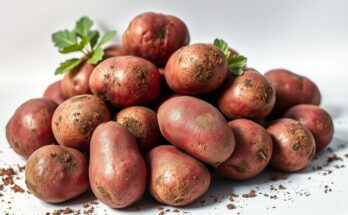Are legumes like green peas okay on the Paleo diet, or are they off-limits? This question has caused a lot of debate among those who follow the diet and health experts.
The Paleo diet focuses on whole, unprocessed foods. It has different views on legumes. Some people avoid them completely, while others think they can be eaten in small amounts.
Looking into whether green peas fit into the Paleo diet is important. We need to understand the diet’s main ideas and the good things about green peas. This will help us figure out if green peas can be part of a Paleo diet.
The Nutritional Profile of Green Peas
Green peas are known for their bright color and sweet taste. They are packed with health benefits thanks to their rich nutrients. They are a versatile ingredient used in many dishes around the world.
Botanical Classification: Are Peas Vegetables or Legumes?
Green peas are classified as legumes, belonging to the Fabaceae family. Even though they’re called vegetables in cooking, they are actually legumes. This is because of their seed structure and growth.
Macro- and Micronutrient Composition
Green peas are full of important nutrients like proteins, fiber, vitamins, and minerals. A cup of green peas is packed with vitamin K, vitamin C, and manganese. They also have folate and thiamin.

Different Forms: Fresh, Frozen, and Canned Green Peas
Green peas come in fresh, frozen, and canned forms. Fresh peas are full of vitamins and taste sweet. But they don’t last long.
Frozen peas are picked quickly and keep most of their nutrients. Canned peas are easy to use but might have more sodium.
Nutritional Comparison: The nutritional values of fresh, frozen, and canned peas are similar. They all have protein, fiber, and key vitamins and minerals.
Core Principles of the Paleo Diet
The Paleo diet is based on what our ancestors ate. It’s about going back to a diet that matches our genes. Dr. Loren Cordain popularized this idea.
Evolutionary Basis and Philosophy
The evolutionary basis of the Paleo diet is simple. It says our bodies are best suited to the diet of our Paleolithic ancestors. This was from 2.5 million to 10,000 years ago.
It believes our genes haven’t changed much since then. So, our best diet is the one our ancestors had.
Allowed Foods on Traditional Paleo
The Paleo diet lets you eat lean meats, fish and seafood, fresh fruits, vegetables, eggs, and healthy fats. These foods are what our ancestors likely ate.
Restricted Foods and Why They’re Excluded
The diet also excludes foods that came with farming and processing. This includes dairy products, legumes, and processed foods. They’re avoided because they might harm our health.
The Problem with Modern Foods
Modern foods, especially processed ones, are bad for us. They’re full of sugars, unhealthy fats, and artificial additives. The Paleo diet sees these as harmful, leading to diseases like obesity and diabetes.
In short, the Paleo diet focuses on whole, unprocessed foods. It avoids modern, processed, and sugary foods. Understanding these principles helps people make better food choices.
The Controversial Status of Legumes in Paleo
The Paleo diet’s view on legumes is a big debate. People wonder if legumes, like green peas, fit into a diet that mimics our ancient ancestors’ eating habits.
Why Most Legumes Are Excluded
Most legumes are not part of the traditional Paleo diet because of antinutrients. Anti-nutrients can block nutrient absorption and cause stomach problems in some.
Anti-Nutrients: Lectins, Phytates, and Saponins
Legumes have anti-nutrients like lectins, phytates, and saponins. Lectins can lead to inflammation and gut damage in some. Phytates can stop mineral absorption. Saponins might upset stomachs in others.
The Evolution of Paleo Thinking About Legumes
The Paleo diet has changed over time. Now, it’s more open to including legumes. This change shows a better understanding of legumes’ health benefits and how people react to them.
Strict vs. Modified Paleo Approaches
The strict Paleo diet doesn’t include legumes. It focuses on meats, fish, fruits, veggies, nuts, and seeds. But modified Paleo diets might let in some legumes, like green peas. This is based on how well someone can handle them and their nutritional value.
Green Peas: The Paleo Diet Perspective
The debate about green peas on the Paleo diet is intense. It centers on whether green peas fit the Paleo diet’s main rules. This question is about their classification as legumes.
Traditional Paleo Stance on Green Peas
The Paleo diet usually doesn’t include legumes like green peas. This is because they have compounds like lectins and phytates. These can block nutrient absorption and harm gut health, fitting the diet’s evolutionary focus.
Dr. Loren Cordain, a key figure in Paleo, believes in avoiding legumes. He thinks they could harm health.
Modern Paleo Adaptations and Flexibility
But the Paleo diet has evolved to be more open to legumes, including green peas. Some say that certain ways of preparing them can reduce the negative effects. This makes green peas a possible choice.
What Leading Paleo Experts Say About Green Peas
Experts like Robb Wolf and Mark Sisson have different opinions on green peas. Some say they should be avoided because of their antinutrients. Others think they can be okay in small amounts if prepared right.
Scientific Evidence Supporting Different Viewpoints
Research on green peas shows both their good and bad sides. They are full of vitamins, minerals, and fiber, which is good. But their lectin content might cause problems for some people’s gut health.
The science on green peas is still growing. It gives Paleo dieters important information to consider.
The Case For Including Green Peas in Your Paleo Diet
Green peas are often debated because they are legumes. But they offer health benefits that fit well with Paleo diets. Unlike other legumes, green peas have less of certain harmful compounds.
Nutritional Density and Beneficial Compounds
Green peas are packed with vitamins, minerals, and antioxidants. They are especially rich in vitamin K, vitamin C, and manganese. These nutrients are good for your health.
The antioxidants in green peas fight oxidative stress and inflammation. This helps keep you healthy.
Lower Anti-Nutrient Content Than Other Legumes
Green peas have fewer lectins and phytates than other legumes. This makes them easier to digest for those on a Paleo diet. It also lowers the risk of digestive problems.
Fiber Content and Gut Health Benefits
Green peas are good for your gut because of their fiber. This fiber helps keep your gut microbiome diverse. A diet rich in fiber is linked to better digestion, immune function, and mental health.
Eating green peas can improve your gut health and overall well-being.
Preparation Methods That Increase Compatibility
To make green peas fit better with Paleo diets, try certain cooking methods. Soaking, sprouting, or cooking can reduce harmful compounds. This makes their nutrients easier to use by your body.
These methods can also help with digestion. So, green peas can be a good choice for Paleo dieters.
In summary, green peas are a great addition to Paleo diets. They are nutritious, have less harmful compounds, and are good for your gut. With the right cooking methods, you can enjoy their benefits while following Paleo principles.
The Case Against Green Peas on Paleo
Green peas might not fit well in a Paleo diet. They have some good points, but there’s a lot of debate about them.
Anti-Nutrient Concerns and Digestive Issues
Green peas contain anti-nutrients like lectins and phytates. These can block nutrient absorption and cause stomach problems. Lectins can also cause inflammation and damage the gut lining, leading to health issues.
For those on a Paleo diet, avoiding foods that cause inflammation or stomach problems is key. Green peas are a big concern here.
Carbohydrate Content and Blood Sugar Impact
Green peas have a lot of carbs, which is a problem for Paleo dieters watching their carb intake. The high carb content can raise blood sugar levels, which goes against the Paleo diet’s goals of managing blood sugar and insulin sensitivity.
This is important for those with diabetes or insulin resistance who use the Paleo diet to help manage their condition.
Evolutionary Inconsistency Arguments
Some say green peas don’t fit with the Paleo diet because they’re not from the Paleolithic era. Since peas are legumes and not typical of the Paleolithic diet, they don’t align with its principles.
Potential Inflammatory Responses
Some people might get inflammatory responses from eating green peas. This could be because of their lectin content or other factors. For those on a Paleo diet, aiming to reduce inflammation, green peas could be a problem.
In summary, green peas have some good points, but their drawbacks are significant. These include anti-nutrients, high carbs, not fitting the Paleo diet’s evolutionary basis, and the risk of inflammation. For some, these reasons make green peas a bad choice for a Paleo diet.
Comparing Green Peas to Other Legumes
When looking at green peas and the Paleo diet, it’s key to compare them to other legumes. This helps us understand their nutritional value, how well they’re digested, and if they fit into the Paleo diet.
Green Peas vs. Beans, Lentils, and Peanuts
Green peas stand out from beans, lentils, and peanuts because of their lower anti-nutrient content and better digestibility. Since they’re often eaten fresh or frozen, they might have fewer anti-nutrients than dried legumes.
Beans and lentils have more phytates and lectins, which can block nutrient absorption and harm gut health. Green peas, on the other hand, have less phytate, making them easier for some to digest on the Paleo diet.
Digestibility and Anti-Nutrient Comparison
Legumes differ in how well they’re digested. Green peas are easy to digest because they have less fiber and anti-nutrients than other legumes. This makes them a good choice for those who struggle with legume digestion.
Seasonal Availability and Evolutionary Context
Green peas are seasonally available and have been eaten for centuries, mainly in spring and early summer. They fit well with the Paleo diet’s focus on eating foods in season.
Processing and Preparation Differences
How green peas are processed and prepared affects their nutrition and digestibility. Fresh or frozen peas are better than canned ones because they have lower sodium content and fewer additives. Cooking them right, like steaming or sautéing, helps keep their nutrients.
In summary, comparing green peas to other legumes shows their special place in the Paleo diet. Their lower anti-nutrient content and better digestibility support their inclusion, but it’s important to consider individual tolerance.
Green Peas and the Autoimmune Protocol (AIP) Diet
The Autoimmune Protocol (AIP) diet is a stricter version of the Paleo diet. It has specific rules that make people question green peas. This diet aims to manage autoimmune diseases by removing harmful foods.
Fundamentals and Restrictions of the AIP Diet
The AIP diet removes foods that might trigger autoimmune issues. It bans grains, legumes, dairy, nightshades, eggs, nuts, seeds, and processed foods. Instead, it focuses on foods like meats, fish, veggies, fruits, and healthy fats.
Exclusion of Green Peas from AIP
Green peas are not allowed in the AIP diet because they are legumes. Legumes have anti-nutrients like lectins and phytates. These can irritate the gut and trigger autoimmune responses in some people.
Reintroduction Protocols for Green Peas
After following the AIP diet strictly, people may reintroduce foods one at a time. When adding green peas, start with a small amount. Watch for reactions over 24 hours.
Success Stories and Cautionary Tales
Some people have added green peas back into their diet without issues. But others have seen their autoimmune symptoms worsen. This shows the need for a personalized approach to diet.
It’s vital for AIP dieters to listen to their bodies. While green peas are nutritious, they might not be right for everyone.
Getting advice from a healthcare provider or nutritionist can help. They can guide you through the AIP diet and food reintroduction.
Paleo-Friendly Alternatives to Green Peas
Green peas might not fit everyone’s Paleo diet. But, there are many other foods that offer similar benefits. Look for veggies and Paleo foods that match in nutrition, taste, and texture.
Nutrient-Comparable Paleo-Approved Vegetables
Many veggies can replace green peas in your diet. Spinach and kale are full of vitamins and minerals. They’re great choices. You can also try broccoli, cauliflower, and Brussels sprouts. They’re packed with nutrients and can be cooked in many ways.
Texture and Flavor Substitutes in Cooking
To get the feel and taste of green peas, use green beans, asparagus, or zucchini. These veggies can be cooked to taste like green peas. Try sautéing or roasting them to bring out their flavors.
Recipe Adaptations for Pea-Free Paleo Meals
It’s easy to make recipes without green peas. Just get creative. For stir-fries, use diced bell peppers or celery. In soups, add leafy greens like spinach or kale towards the end. This keeps their nutrients intact.
Seasonal Considerations for Alternatives
Choose veggies based on the season for freshness and variety. Summer squash is perfect in summer, while root vegetables like carrots and parsnips are better in winter. This supports local farming and makes your Paleo diet more interesting.
Conclusion: Making an Informed Decision About Green Peas
The debate on green peas in a paleo diet is complex. Green peas are full of fiber and protein, which is good for health. But, they are legumes, which some paleo diets avoid because of anti-nutrients.
Whether to include green peas in a paleo diet is up to each person. If you value nutritional density and have a healthy gut, green peas are a good choice. But, if you have autoimmune issues or are sensitive to anti-nutrients, it’s best to limit or avoid them.
By considering the points in this article, you can decide what’s best for you. This ensures your paleo diet is balanced and sustainable.
FAQ
Are green peas allowed on the Paleo diet?
The Paleo diet has mixed views on green peas. Some people avoid all legumes, including green peas. Others see them as okay because they have less anti-nutrients and are very nutritious.
What are the nutritional benefits of green peas?
Green peas are packed with protein, fiber, and vitamins like K and folate. They also have manganese and antioxidants.
How do green peas compare to other legumes in terms of anti-nutrient content?
Green peas have less anti-nutrients than beans and lentils. They have fewer lectins and phytates, which can be easier to digest.
Can I include green peas in an Autoimmune Protocol (AIP) diet?
The AIP diet usually doesn’t include legumes, like green peas, because they might cause inflammation. But some people might be able to add green peas later, based on how they react.
Are there Paleo-friendly alternatives to green peas?
Yes, you can use other veggies like spinach, kale, zucchini, and bell peppers. They’re similar in nutrition and can replace green peas in Paleo recipes.
How can I prepare green peas to make them more Paleo-friendly?
Steaming or sautéing green peas can lower their anti-nutrient levels. Soaking and sprouting can also help, but these are more common for other legumes.
Are canned green peas acceptable on the Paleo diet?
Canned green peas are not usually good for the Paleo diet. They might have added sugars, sodium, and other non-Paleo stuff. It’s better to use fresh or frozen green peas.




